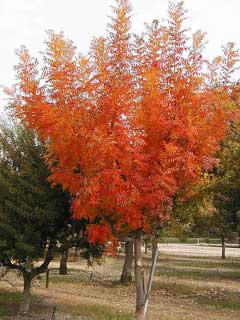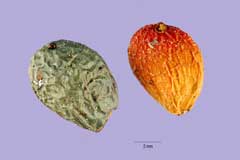 |
|
|
 |
| Tracey Slotta @ USDA-NRCS PLANTS Database |
Translate this page:
Summary
Bloom Color: Green. Main Bloom Time: Mid spring. Form: Oval, Rounded, Spreading or horizontal, Vase.
Physical Characteristics

 Pistacia chinensis is a deciduous Tree growing to 9 m (29ft 6in) at a slow rate.
Pistacia chinensis is a deciduous Tree growing to 9 m (29ft 6in) at a slow rate.
See above for USDA hardiness. It is hardy to UK zone 8. It is in flower from April to June, and the seeds ripen in October. The species is dioecious (individual flowers are either male or female, but only one sex is to be found on any one plant so both male and female plants must be grown if seed is required). . The plant is not self-fertile.
Suitable for: light (sandy), medium (loamy) and heavy (clay) soils. Suitable pH: mildly acid, neutral and basic (mildly alkaline) soils. It cannot grow in the shade. It prefers dry or moist soil.
UK Hardiness Map
US Hardiness Map
Synonyms
Plant Habitats
Woodland Garden Secondary; Sunny Edge;
Edible Uses
Edible Parts: Leaves Seed Shoots
Edible Uses:
Young shoots and leaves - cooked. Used as a vegetable[11, 46, 182, 183]. Seed - cooked. It is roasted and then eaten, or is used in confectionery[105, 183].
References More on Edible Uses
Medicinal Uses
Plants For A Future can not take any responsibility for any adverse effects from the use of plants. Always seek advice from a professional before using a plant medicinally.
Miscellany
Resin from the related P. lentiscus is analgesic, antitussive, expectorant and sedative. It would be worthwhile examining this species[218].
References More on Medicinal Uses
The Bookshop: Edible Plant Books
Our Latest books on Perennial Plants For Food Forests and Permaculture Gardens in paperback or digital formats.

Edible Tropical Plants
Food Forest Plants for Hotter Conditions: 250+ Plants For Tropical Food Forests & Permaculture Gardens.
More

Edible Temperate Plants
Plants for Your Food Forest: 500 Plants for Temperate Food Forests & Permaculture Gardens.
More

More Books
PFAF have eight books available in paperback and digital formats. Browse the shop for more information.
Shop Now
Other Uses
Dye Miscellany Rootstock Wood
The plant can be used as a rootstock for the pistachio nut, P. vera[200]. A yellow dye can be obtained from the wood[266]. Wood - hard, durable. Used in furniture making and carpentry[51, 266].
Special Uses
References More on Other Uses
Cultivation details
Landscape Uses:Pest tolerant, Pollard, Specimen, Street tree. Succeeds in an ordinary loamy soil and in dry soils[1, 11]. Requires a sunny position[1]. This species is not hardy in the colder areas of the country, it tolerates temperatures down to between -5 and -10°c[200]. A very ornamental tree[1, 11]. Any pruning that needs to be done is best carried out in the spring[238]. This species strongly resents being transplanted[113], it should be planted out into its permanent position as young as possible and given some protection from winter cold for its first few winters outdoors. Dioecious, male and female plants must be grown if seed is required. Special Features:Not North American native, Naturalizing, Inconspicuous flowers or blooms.
References Carbon Farming Information and Carbon Sequestration Information
Temperature Converter
Type a value in the Celsius field to convert the value to Fahrenheit:
Fahrenheit:
The PFAF Bookshop
Plants For A Future have a number of books available in paperback and digital form. Book titles include Edible Plants, Edible Perennials, Edible Trees,Edible Shrubs, Woodland Gardening, and Temperate Food Forest Plants. Our new book is Food Forest Plants For Hotter Conditions (Tropical and Sub-Tropical).
Shop Now
Plant Propagation
Pre-soak the seed for 16 hours in alkalized water[78], or for 3 - 4 days in warm water[1], and sow late winter in a cold frame or greenhouse[78, 113]. Two months cold stratification may speed up germination, so it might be better to sow the seed in early winter[113]. The germination is variable and can be slow. Prick out the seedlings into individual pots when they are large enough to handle and grow on the plants for at least their first winter in a greenhouse. Plant out into their permanent positions in early summer and consider giving some protection from winter cold for their first year or two outdoors[K]. Cuttings of half-ripe wood from juvenile trees, July in a frame[113]. Layering.
Other Names
If available other names are mentioned here
Native Range
TEMPERATE ASIA: China (Anhui Sheng, Fujian Sheng, Gansu Sheng, Guangdong Sheng, Guangxi Zhuangzu Zizhiqu, Guizhou Sheng, Hainan Sheng, Hebei Sheng, Henan Sheng, Hubei Sheng, Hunan Sheng, Jiangsu Sheng, Jiangxi Sheng, Shaanxi Sheng, Shandong Sheng, Shanxi Sheng, Sichuan Sheng, Xizang Zizhiqu (se), Yunnan Sheng, Zhejiang Sheng), Taiwan TROPICAL ASIA: Philippines (Luzon)
Weed Potential
Right plant wrong place. We are currently updating this section.
Please note that a plant may be invasive in one area but may not in your area so it's worth checking.
Conservation Status
IUCN Red List of Threatened Plants Status :

Growth: S = slow M = medium F = fast. Soil: L = light (sandy) M = medium H = heavy (clay). pH: A = acid N = neutral B = basic (alkaline). Shade: F = full shade S = semi-shade N = no shade. Moisture: D = dry M = Moist We = wet Wa = water.
Now available:
Food Forest Plants for Mediterranean Conditions
350+ Perennial Plants For Mediterranean and Drier Food Forests and Permaculture Gardens.
[Paperback and eBook]
This is the third in Plants For A Future's series of plant guides for food forests tailored to
specific climate zones. Following volumes on temperate and tropical ecosystems, this book focuses
on species suited to Mediterranean conditions—regions with hot, dry summers and cool, wet winters,
often facing the added challenge of climate change.
Read More
Expert comment
Author
Bunge.
Botanical References
1151200
Links / References
For a list of references used on this page please go here
Readers comment
| Add a comment |
|
If you have important information about this plant that may help other users please add a comment or link below. Only comments or links that are felt to be directly relevant to a plant will be included. If you think a comment/link or information contained on this page is inaccurate or misleading we would welcome your feedback at [email protected]. If you have questions about a plant please use the Forum on this website as we do not have the resources to answer questions ourselves.
* Please note: the comments by website users are not necessarily those held by PFAF and may give misleading or inaccurate information.
To leave a comment please Register or login here All comments need to be approved so will not appear immediately.
|
Subject : Pistacia chinensis
|
|
|
|